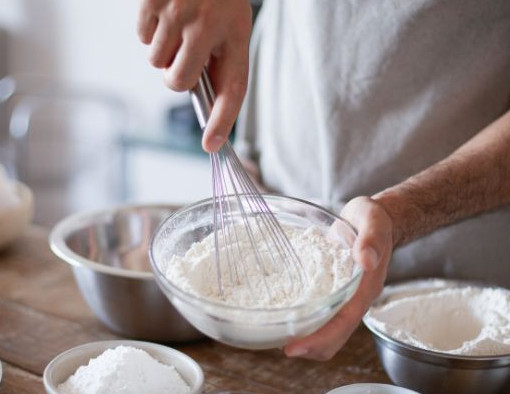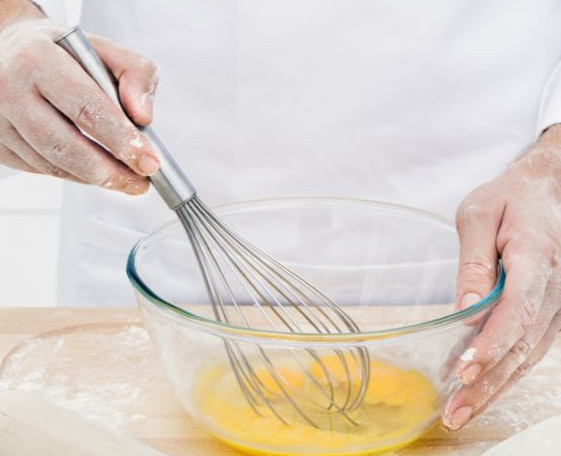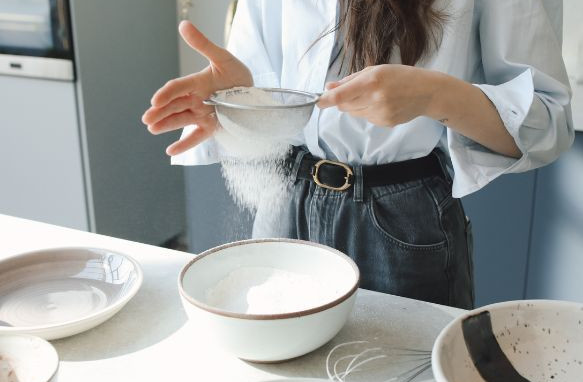Baking can be fun, but there is nothing more frustrating, especially if you are a beginner to come across baking terms in a recipe such as “creaming”, “folding”, or “proofing,” and you have no idea what they mean. Understanding baking lingo is necessary to achieve the correct results when making that pie or cake. In this article, I will explain some of these necessary terms so that you can make that baked good with confidence.
What Does “Cream Butter And Sugar” Mean?


The recipe you are following states to cream the sugar and butter. What does this mean? It simply means to mix the 2 together with either a hand mixer or stand mixer on a low to medium setting until they are fully mixed and fluffy and the mixture has turned to a pale yellow. This applies to shortening as well. This mixture should be light and fluffy.
Your butter should be at room temperature. If it is too cold, the sugar will be harder to mix in with the butter. On the other hand, if the butter is too warm once it is mixed with the sugar, it will not be able to correctly hold the other ingredients; therefore, your finished baked goods will not have the right texture.
The purpose of creaming the butter and sugar is to add air to the butter, which in turn will support the texture and structure of your baked good.
Creaming butter and sugar is usually the first step when making cookies and cakes.
Whisk




Many recipes state to whisk dry ingredients. This step can replace sifting. When the dry ingredients are whisked, the particles of the dry ingredients are separated, and air is introduced.
The same with whisking eggs. The purpose is to add air to the ingredients. This can be done with a wire whisk or if you are using a mixer, the whisk attachment.
Sift


Put your flour through a sifter or fine mesh sieve. This will remove any lumps in the flour and should be done before measuring your flour for more accurate measurements.
The sifted flour is also lighter and, when added to other ingredients, will make mixing easier.
Fold
This is a technique used to combine a lighter ingredient into a heavier one gently. For instance, when making angel food cake. You will fold the whipped egg whites into the cake batter. This is usually done in 3 increments. Add 1/3 of the whipped egg whites, with a spatula cut through the center of both mixtures and bring the batter back to the top. Continue this down across up and over motion gently until the egg whites are evenly distributed into the batter. Do not stir. You will deflate the egg whites.
This technique is most commonly used when making angel food cakes, chiffon or sponge cakes, mousses, and souffles. See the video below on how to fold ingredients.
Knead

Kneading is basically stretching your dough to develop the gluten. The gluten strands trap air and help the bread to rise.
Set your dough onto a lightly floured surface. Push the dough away from you with the heel of your hands. Fold the dough onto itself, turn the dough, and then again push the dough away with the heel of your hands. Continue this until your dough is smooth and elastic.
This can take 10-12 minutes by hand. But you can cheat if you have a stand mixer with the dough hook attachment. I do! 8-10 minutes will usually do it.
Proof

This term refers to the last rise of your yeast product, such as bread. When making yeast products, there are 2 rises. The first is after you have needed the dough. After this first rise, you then shape your dough and let it rise again. This resting time(proofing or second rise) allows the yeast to release carbon dioxide and the gluten to stretch to hold the air bubbles.
Dock

Simply means to prick your dough all over with a fork. Most of the newer cookbooks on the market will say to prick the dough with a fork. But if you happen to have an older cookbook that has been in your family for years, it will most likely have the term dock.
Why is it important to do this step? Pricking the crust with a fork allows steam to escape and prevents those pesky bubbles from forming and the crust from baking unevenly.
Blind Bake

This term applies especially when you are making a custard pie. A lemon meringue filling is cooked before adding it to your crust. So, your pie crust needs to be baked beforehand. This is called “blind Baking” your pie crust. Once your crust is baked and cooled then you add your filling. But wait, what about the meringue? Well, you add it to your lemon filling and bake it just until the meringue has browned slightly.
If making an old fashion chocolate pie, you will bake the crust and let it cool, then add your chocolate filling and refrigerate.
But then you have par-baking, which just means that you partially bake the pie crust, add your filling, and finish baking. Par baking helps to prevent a soggy bottom.
Beat

To thoroughly mix your ingredients using either a wooden spoon or the paddle attachment on a stand mixer, until the batter is smooth. But if you are beating eggs, most recipes state “slightly or lightly beaten eggs”. What does this mean? You just want to beat them with a fork or whisk to a pale yellow color.
You do want to take care and not overbeat your batter. Whether you are making cookies or cake, overbeating can cause gluten to form and the result will be a dense and chewy texture.
Whip
You also use a whisk when whipping ingredients. With whipping, you are vigorously beating so that air is incorporated into the ingredients. For example, egg whites are whipped until they increase in volume due to all that air. This makes for a light and fluffy Angel Food Cake.
Do not get whisking and whipping confused. Whisking is just mixing ingredients together quickly.
What Are Soft And Stiff Peaks?


Depending on the recipe you will either whip until soft peaks or stiff peaks appear. What is the difference? Soft peaks barely hold their shape and will plop over when the beaters are lifted. You want soft peaks when you are adding whipped egg whites to simply lighten a dish.
Stiff peaks will stand straight up, and the tips don’t curl when you lift the beaters. You will also know that they are at the stiff peak stage by turning the bowl upside down, and the egg whites stay in the bowl. You want stiff peaks when you are making meringue for that lemon meringue pie.
The general rule when using a mixer at medium-high is 4-5 minutes for soft peaks and 8-9 minutes for stiff peaks. This will differ depending on how many egg whites, the temperature of the eggs and the room, and how powerful your mixer is.
What Is “Mix Just Until Combined”?
You will mix until you no longer see the ingredient you just added. For example, if you just added flour to your wet ingredients, you will stop mixing once you no longer see the flour. Many want to continue mixing until all the lumps are gone. But actually, a few small lumps are ok. If you continue to mix, then you will run into over-mixing the batter. And you really don’t want to do that. Why? Because the gluten in the flour may form gluten strands that will result in a dense and chewy texture. This could be a good thing in cookies. But you definitely don’t want this to happen when making a cake.
What Does “Cut In” Mean?

This is especially important when making pie crust. To cut in butter or shortening simply means to work the cold fat into the flour with either a pastry blender or 2 knives until the mixture resembles peas. Those little pieces of fat are what make your pie crust or pastry flaky.
This can also be done in a food processor with just a few quick pulses. Just make sure that you do not overdo it. You want those pea-size pieces of butter or shortening. They will release steam, creating small air pockets in the pastry or pie crust. And this will make your finished product flaky and delicious.
Final Thoughts
Learning baking lingo is key to becoming a better baker. Nothing is more frustrating than coming across baking terms you have no idea what they mean. But with the explanation of some of these baking terms, you should be able to cruise your way through the baking process. Understanding baking lingo such as “Kneading,” “docking,” and “blind baking” will help you to make that great pie.
Baking should be fun and rewarding. Knowing your baking lingo and with practice and patience, your baking skills will get better and better. Remember, baking is love made visible.
Please leave me a comment below. I would love to hear about your thoughts and any baking terms I forgot.
And As Always
Keep On Baking!
Taianne

I’m Taianne, the owner and operator behind We Are Baking. Baking my first cake at age 11 hooked me on creating sweet treats. Though my interest faded during childhood, it was rekindled when I married my apple pie-loving husband. I love trying new recipes, tweaking classics, and helping others learn the science and art of baking. I started We Are Baking to share tips, tricks, and favorite recipes I’ve discovered over the years. When not in the kitchen, I enjoy spending time with family and friends. My goal is to inspire others to embrace their creativity through baking. Feel free to contact me with any questions!
Taianne@wearebaking.com

